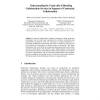Free Online Productivity Tools
i2Speak
i2Symbol
i2OCR
iTex2Img
iWeb2Print
iWeb2Shot
i2Type
iPdf2Split
iPdf2Merge
i2Bopomofo
i2Arabic
i2Style
i2Image
i2PDF
iLatex2Rtf
Sci2ools
CRIWG
2006
2006
Understanding the Trade-Offs of Blending Collaboration Services in Support of Contextual Collaboration
Contextual collaboration seamlessly integrates existing groupware technologies into a uniform user experience that combines synchronous and asynchronous interactions. This user experience is usually supported by a contextual collaboration infrastructure that needs to efficiently cope with the fast switching and integration of different modes of interaction. This paper experiments with a new model for contextual collaboration based on the notion of generic shared objects. We describe a native implementation of this model and evaluate its behavior under different media traffic conditions. We compare the native implementation with an alternative implementation that integrates existing notification and meeting servers to deliver the same model behavior. We discuss trade-offs and limitations of those two implementations.
Contextual Collaboration | Contextual Collaboration Infrastructure | CRIWG 2006 | CRIWG 2007 | User Experience |
| Added | 30 Oct 2010 |
| Updated | 30 Oct 2010 |
| Type | Conference |
| Year | 2006 |
| Where | CRIWG |
| Authors | Roberto Silveira Silva Filho, Werner Geyer, Beth Brownholtz, David F. Redmiles |
Comments (0)

